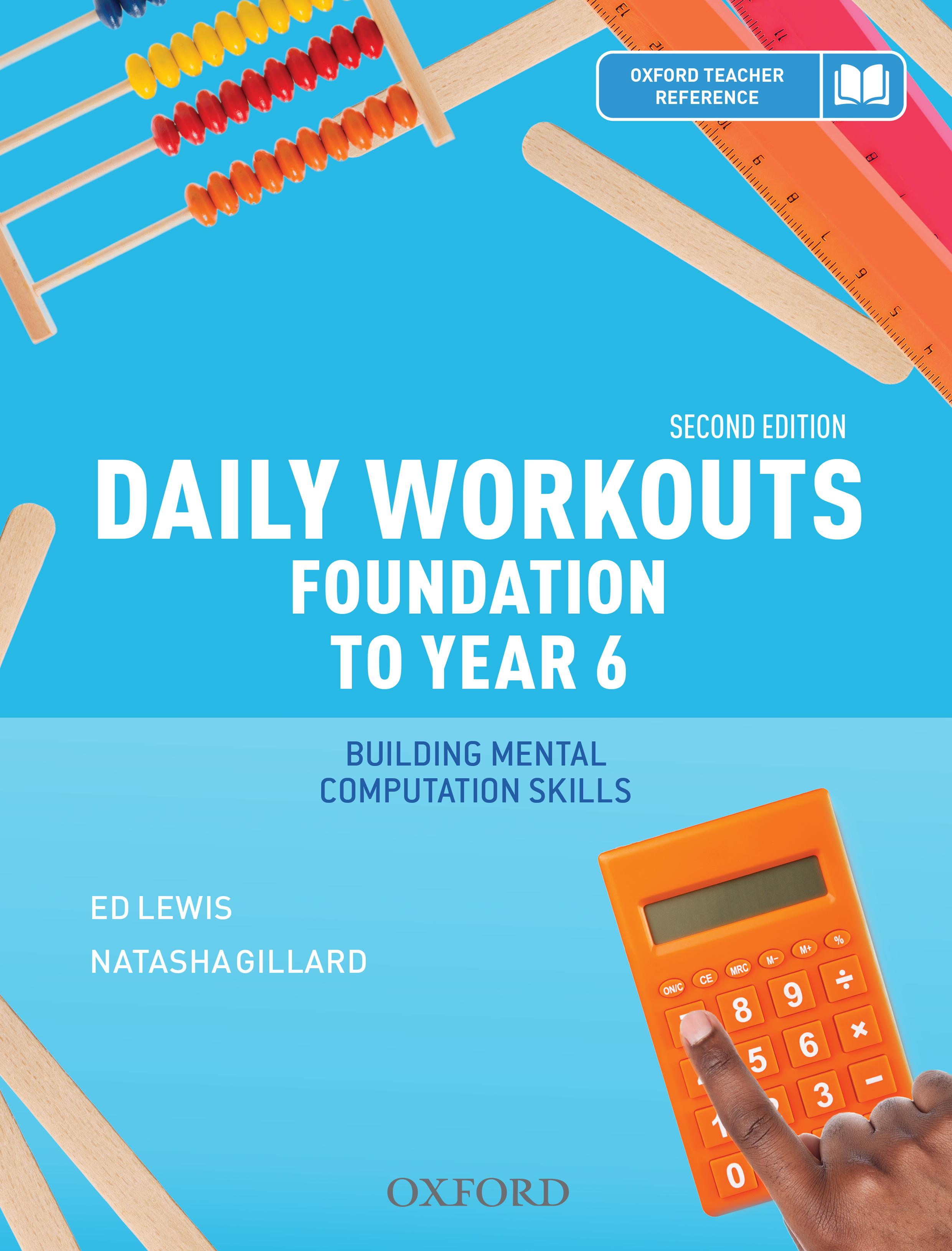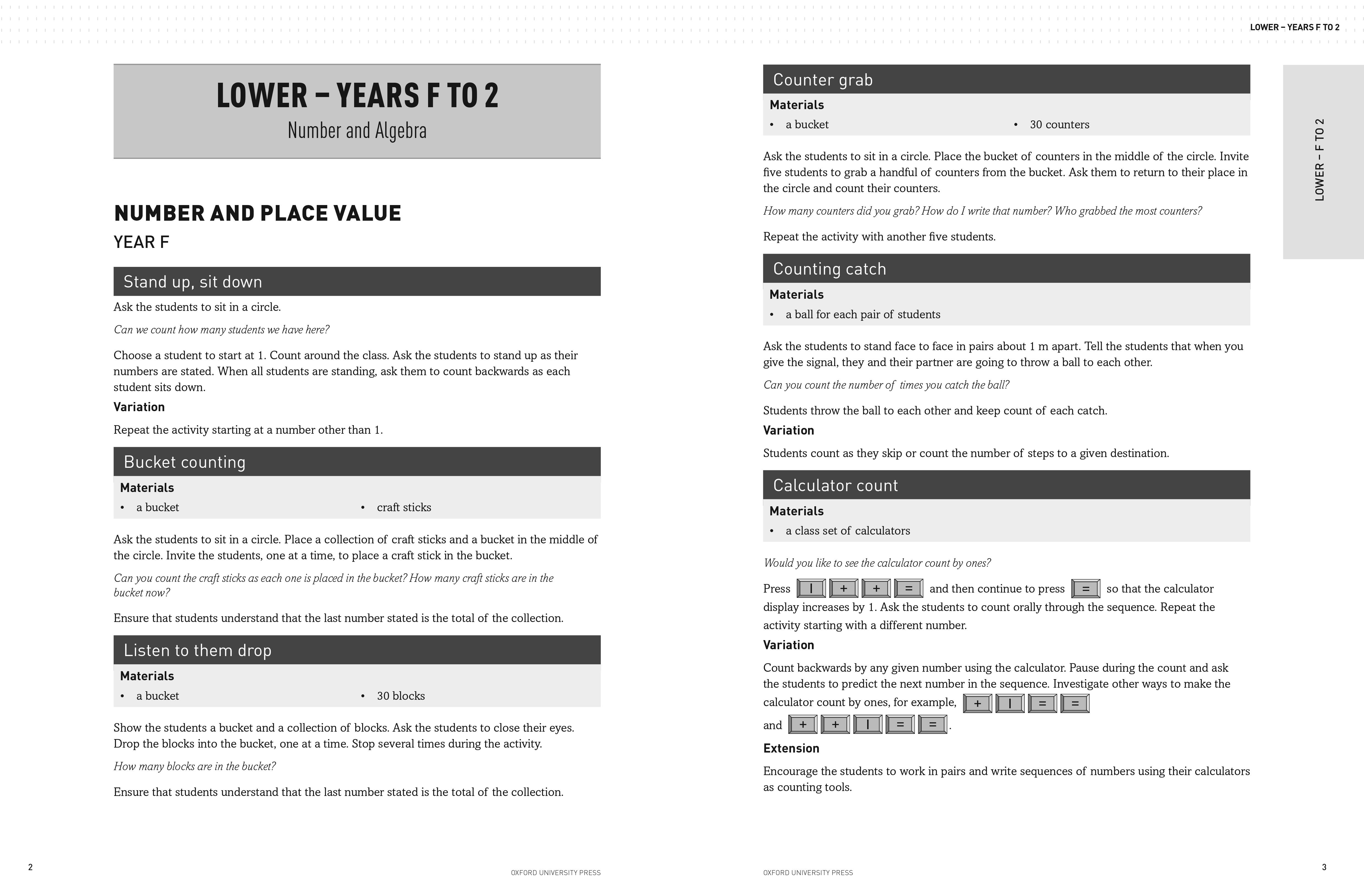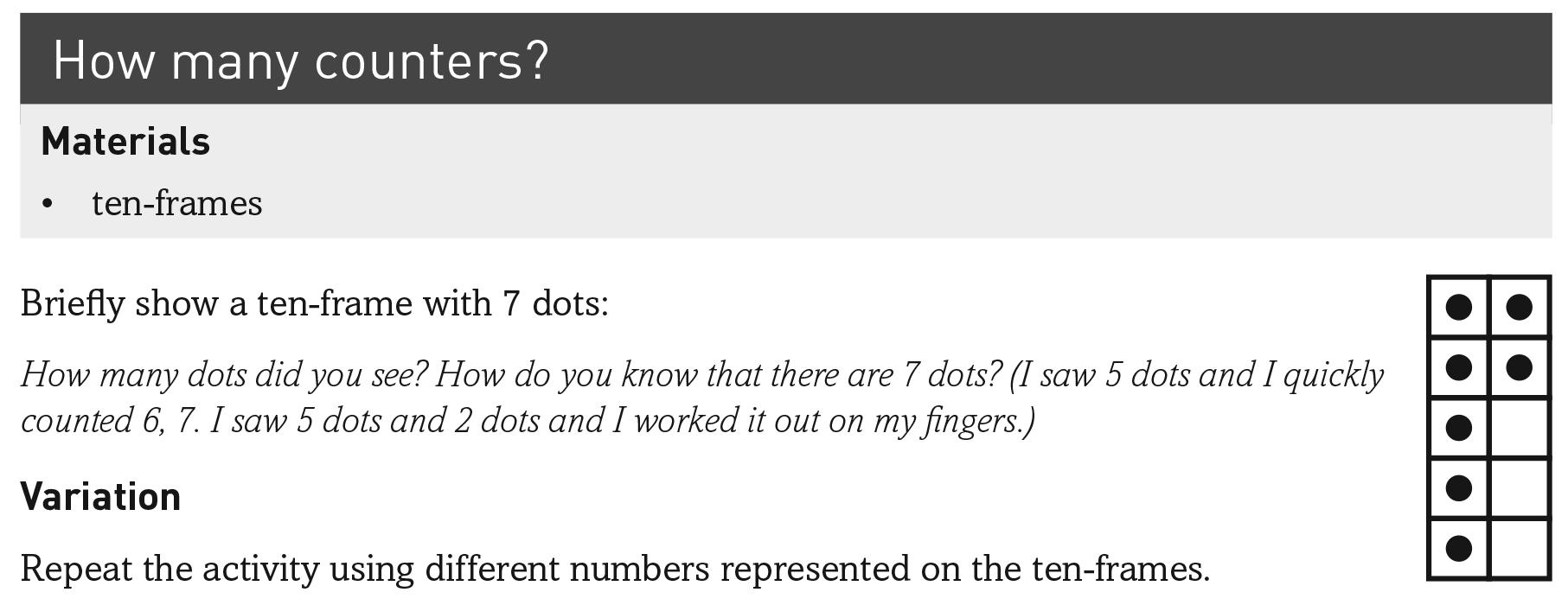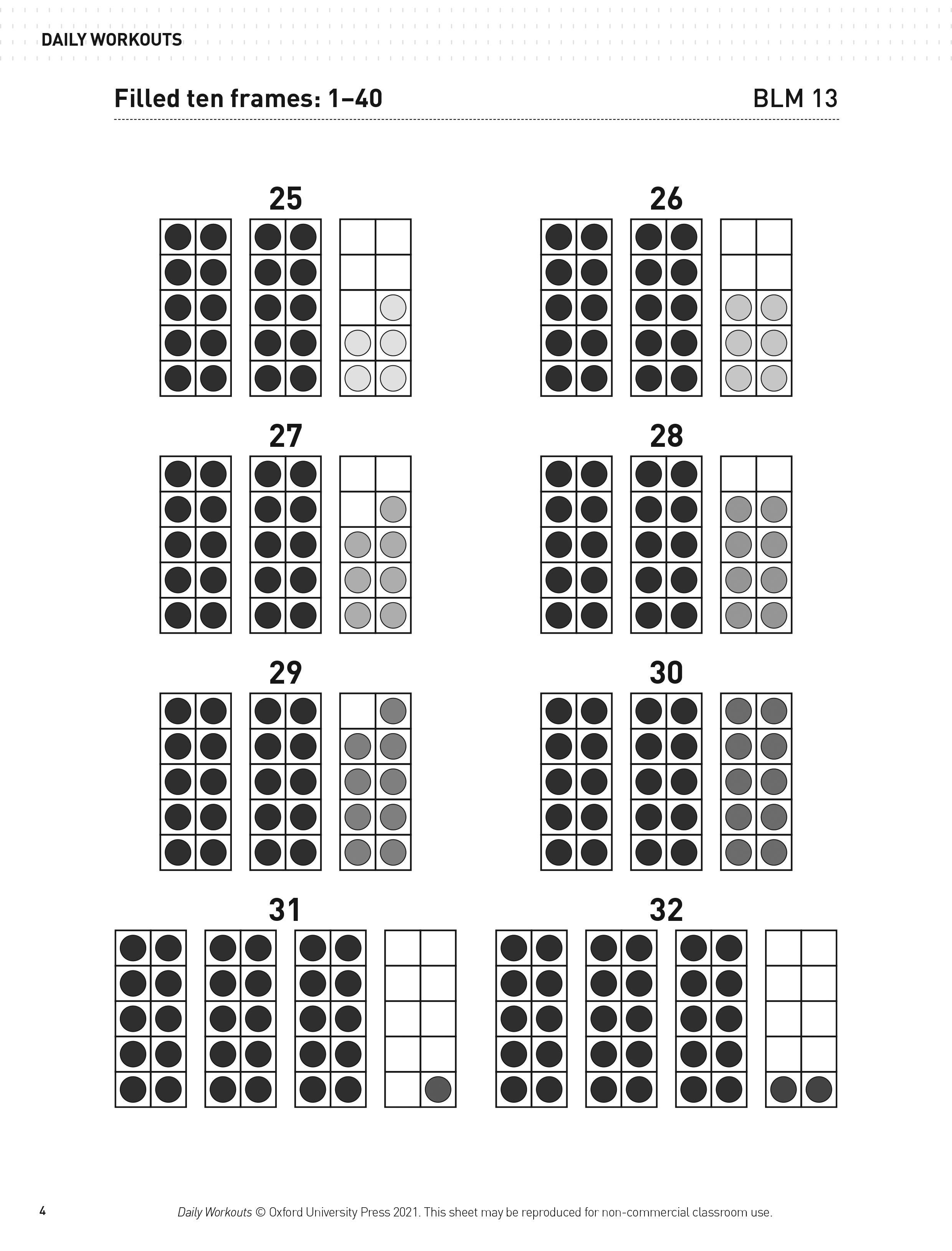

Introduction
About Daily Workouts
Daily Workouts is a primary mathematics resource offering a comprehensive range of daily activities fostering mental computation and the development of mathematical skills, thinking and understandings. It is aligned with the Australian Curriculum: Mathematics, Number and Algebra strand and incorporates the proficiencies of understanding, fluency, problem-solving and reasoning.
What is mental computation?
Mental computation is a cognitive process used to produce an exact answer by mental methods, without the need for external devices such as pencil and paper or the electronic calculator – although pencils, paper and calculators can be and are used in this book to help develop mental skills. Mental computation requires the use of different strategies and instant recall of basic facts from memory in solving problems. The effect of manipulating numbers ‘in the head’ promotes the development of number sense, or a ‘feel’ for how numbers work.
Why use mental computation?
Mental mathematics is crucial for everyday living. It has been established that 80% of calculations made by adults are made mentally. Often estimation is needed to determine whether an answer obtained electronically is reasonable or not, for example, during shopping. Daily Workouts aids in the development of these necessary estimation skills.
How do I use Daily Workouts to teach mental computation?
Each activity in Daily Workouts has been designed as a teacher-led discussion to promote verbal communication among students, enhancing their thinking and reasoning. Activities have been designed primarily as lesson warm-ups, in which the teacher and students discuss and develop mathematical ideas. The activities may be also used flexibly during lesson breaks or for revision of previous concepts.
The activities in Daily Workouts are laid out in inquiry style with scripts of possible teacher questions and student responses/answers provided so that teachers can extend discussion and develop different ideas about the problem. Instead of drilling a fixed mental strategy in isolation, the teacher needs to explore a range of strategies suggested by the students, according to the type of activity given. In each case, the students are given a short time to investigate the problem concerned, before considering a variety of solution methods in classroom discussion with the teacher. The strategies that are most efficient are thus investigated and highlighted.
How do teachers assess students’ mental computation strategies?
By allowing students enough time to discuss their mathematical thinking and not intervening too soon, the teacher can observe and note their responses, which provide a window to their thoughts. Requesting students to justify their strategies by asking questions such as ‘Why?’, ‘How do you know that?’ or ‘Can you prove that?’ can elicit further responses.
Skills in mental computation are thus best developed by students constructing their own knowledge from physical and mental activities in problem-solving contexts. The classroom emphasis should be on students’ investigation, discussion and implementation of various mental methods, as their strategy of first choice when solving number problems, but answers are also provided for some problems.
How to use this book
Daily Workouts is designed to offer teachers a curated collection of activities to support mental computation and mathematical thinking. The activities are intended as 5- to 10-minute introductions or warm-ups in which the teacher and students are engaged in discussion and explanation.
Activities
Activities are organised by primary year group, strand, concept, topic and year level. A handy thumb tab helps to identify each year group – Lower, Middle and Upper. Supplementary activities can also be found on Oxford Owl, along with digital resources, including curriculum links, to support all of the activities.
Materials
Each activity includes a list of materials to allow teachers to prepare in advance – it is assumed that everyday classroom materials such as paper, pencils, counters, Unifix or Multilink cubes and Base 10 materials are readily available.
Instructions
Each activity includes clear and simple instructions and a script featuring teacher dialogue and student responses that may lead to more class discussion and consideration of the problem or question. (Sometimes the answer is provided for quick reference, too.) Suggestions for variations and extension are also included where relevant.

Title
List of materials needed
Instructions
Teacher dialogue and possible student responses

Diagram
Variation activity
BLMs
All BLMs are available online at www.oxfordowl.com.au.
They include number cards, grids and templates, such as 3 × 3 grids, 4 × 4 grids, multiplication chart, hundreds chart, ten-frames, ten-strips and arrays.

LOWER – YEARS F TO 2
Number and Algebra
NUMBER AND PLACE VALUE
Year F
Stand up, sit down
Ask the students to sit in a circle.
Can we count how many students we have here?
Choose a student to start at 1. Count around the class. Ask the students to stand up as their numbers are stated. When all students are standing, ask them to count backwards as each student sits down.
Variation
Repeat the activity starting at a number other than 1.
Bucket counting
Materials
• a bucket
• craft sticks
Ask the students to sit in a circle. Place a collection of craft sticks and a bucket in the middle of the circle. Invite the students, one at a time, to place a craft stick in the bucket.
Can you count the craft sticks as each one is placed in the bucket? How many craft sticks are in the bucket now?
Ensure that students understand that the last number stated is the total of the collection.
Listen to them drop
Materials
• a bucket
• 30 blocks
Show the students a bucket and a collection of blocks. Ask the students to close their eyes. Drop the blocks into the bucket, one at a time. Stop several times during the activity.
How many blocks are in the bucket?
Ensure that students understand that the last number stated is the total of the collection.
Counter grab
Materials
• a bucket
• 30 counter s
Ask the students to sit in a circle. Place the bucket of counters in the middle of the circle. Invite five students to grab a handful of counters from the bucket. Ask them to return to their place in the circle and count their counters.
How many counters did you grab? How do I write that number? Who grabbed the most counters?
Repeat the activity with another five students.
Counting catch
Materials
• a ball for each pair of students
Ask the students to stand face to face in pairs about 1 m apart. Tell the students that when you give the signal, they and their partner are going to throw a ball to each other.
Can you count the number of times you catch the ball?
Students throw the ball to each other and keep count of each catch.
Variation
Students count as they skip or count the number of steps to a given destination.
Calculator count
Materials
• a class set of calculators
Would you like to see the calculator count by ones?
Press + + = 1 and then continue to press = so that the calculator display increases by 1. Ask the students to count orally through the sequence. Repeat the activity starting with a different number.
Variation
Count backwards by any given number using the calculator. Pause during the count and ask the students to predict the next number in the sequence. Investigate other ways to make the calculator count by ones, for example, + = = 1
and + + 1 = =
Extension
Encourage the students to work in pairs and write sequences of numbers using their calculators as counting tools.
Counting circle
Ask the students to stand in a circle. Show these numbers: 10 20 30
What do you notice about these numbers? (They all end in 0.)
Students repeatedly count around the circle from 1 to 30. Each time a student says ‘10’, ‘20’ or ‘30’, that student sits down. Continue to count around the circle until only one student is left standing.
Take a counter
Materials
• 20 counter s
Choose six students to sit in a circle. Place the counters in the middle of the circle and ask the students to count around the group, starting at 1. Each student says a number. If the student states a number with a ‘2’ in it (2, 12, 20, 21, etc.), they collect a counter. When all the counters have been collected, the students count their own total.
How many counters do you have?
Repeat the activity with another group of six students.
Memory game to 10
Materials
• two sets of number cards from 1 to 10
Ask the students to sit in a circle. Place two sets of number cards from 1 to 10 face down in the middle. Choose two students to each turn over a card at the same time.
What is your number?
If the numbers are the same, the two students keep their cards. If not, they return them to the floor face down. Choose another pair of students and repeat the activity until all the cards are collected.
Number match
Materials
• a set of number cards from 1 to10 for each student
• a set of picture cards from 1 to 10
• 10 counter s
Give each student a set of number cards from 1 to 10. Then hold up one card at a time in random order, using dots or pictures, to show 1 to10.
Can you show me the number card that is the same as this number?
Observe the students who need to count the dots one at a time and those that instantly recognise an arrangement for a particular number.
Can you show me the number card that is one more than this number?
Repeat the activity for all numbers from 1 to 10.
Count from. .
Materials
• a bucket
• 13 Multilink or Unifix cubes
Show the students a bucket with 3 cubes in it. Tell the students that there are 3 cubes in the bucket.
Can you tell me how many cubes are in the bucket as I put more cubes in?
Continue to place 10 more cubes in the bucket, one cube at a time. When the students count to 13, remove the cubes from the bucket one at time and ask the students to count backwards by ones. Repeat the activity often. Start with a different number of cubes each time.
Counting fingers
Ask the students to work with a partner for this activity.
Can you and your partner show me 18 fingers altogether?
Allow the students some time to represent 18 fingers.
Can you show me 15 fingers? Can you show me 15 fingers another way?
Encourage the students to count to check the total number of fingers.
Clap and chant
Create a slow rhythmic pattern by clapping your hands then tapping your knees. Encourage students to continue the clapping and tapping pattern. On a ‘clap’, say a number from 1 to 20, such as 16.
Say the number that comes after the number 16 on the next ‘clap’. (17)
Repeat the activity. Choose a number and ask the students to say the number after it on the next clap.
Variation
Repeat the activity for numbers that come before the chosen number.
Compare with five
Materials
• a five-strip
• counter s
Show a blank five-strip. Invite a student to place 5 counters on the five-strip.
How many counters can you see?
Show another blank five-strip. Invite a student to put 4 counters on this strip. Show the counters for 3 seconds:
What did you see? How many counters are there altogether? How do you know there are 9 counters? (I saw 5 counters and I quickly counted 6, 7, 8, 9. I saw 5 and 4 counters.)
Repeat the activity for numbers between 5 and 10.
Making teens
Show these numbers: 15 18 19 16
What do you notice about these numbers? (They all start with the number 1. When you say them you say ‘teen’.)
Choose two students to stand in front of the class. Ask the first student to show 10 fingers. How many fingers does (name of the second student) need to hold up to show 15 fingers altogether?
Ask the two students to show 15 fingers. With the class, count all 15 fingers to check the total. Ask the students to complete this sentence: ‘15 is 10 and (5) more’. Choose other pairs of students to show 16, 18 and 19 fingers.
Memory game to 20
Materials
• two sets of number cards from 11 to 20
Ask the students to sit in a circle. Place two sets of number cards from 11 to 20 face down in the middle. Choose two students to each turn over a card at the same time.
What is your number?
If the numbers are the same, the two students keep their cards. If not, they return them to the floor, face down. Choose another pair of students and repeat the activity until all the cards are collected.
Dice patterns
Materials
• dot dice cards or a dot dice
Briefly show one of the cards, such as the one for 5:
How many dots did you see? What did they look like? (I saw 4 and 1 more in the middle.) How many dots will be there if 1 more was added?
Encourage students to state the number of dots instantly (without counting each dot one by one). Discuss the students’ responses. To check, show the arrangement again. Repeat the activity often using other dot dice cards.
Number strips
Materials
• counter s
Show a number strip with counters placed as follows:
Which numbers are missing?
Discuss the students’ responses. Show or add the missing counters to complete the pattern. Ask the students to work in pairs to construct the pattern with counters.
Variation
A set of random dot cards could also be used for this activity. Students can supply the missing cards in the sequence.
More dots
Materials
• a set of random dot cards from 1 to 10
Show and discuss the terms more and less. Shuffle the dot cards and place them face down in a pile. Turn over the top two cards and show them to the students.
Which card has more dots? How can we check? (We can count the dots.)
Ask the students to count the number of dots on each card. Encourage students to make statements using the terms more or less.
How many more than 3 does 7 have? How did you work it out? (7 is 4 more than 3 and 3 is 4 less than 7)
Discuss the students’ responses. Repeat the activity often using other dot cards.
Estimating dots
Materials
• a set of random dot cards from 1 to 10
Ask the students to close their eyes and imagine 6 dots.
Can you describe what you see? (I imagined two lines of 3 dots, like a dice.)
Show the random dot cards one at a time:
Which one of these cards has 6 dots on it?
Tell the students to raise their hands when they see a card with 6 dots. Repeat the activity for cards showing other numbers of dots.
Variation
Repeat the activity with cards showing more than 10 dots.
More or less?
Materials
• two sets of number cards from 1 to 10
Show this number line:
Which numbers are more than 7? Which numbers are less than 4? How many numbers are less than 8?
12345678910
Shuffle both sets of the number cards and place them face down in two piles (a teacher pile and a student pile). Turn over the top card on the teacher pile and locate the number on the number line. Invite a student to predict whether the top card on their pile will be more or less than the teacher’s card. The student then turns over the next card to check their prediction. Continue the activity until all cards are used.
Ordering numbers
Materials
• a set of number cards from 0 to 10
Give 11 students each a number card from 0 to 10. Ask the students with the cards for 0 and 10 to stand at opposite ends of the room. One at a time, invite the students with the remaining cards to stand where their number is approximately located between 0 and 10.
How do you know where to stand? Which numbers will stand next to you? (Number 2 is closer to 0.)
Continue until all students with number cards have located themselves between 0 and 10.
Before and after Material
• a dot dice
Ask the students to sit in a circle. Roll a dot dice into the middle several times and ask the students to state the number rolled each time.
What is the number that is 1 more than the number rolled? What is the number that is 1 less than the number rolled? How do you know?
Discuss the students’ responses.
Before and after cards
Materials
• a set of number cards from 1 to 10 for each student
Give each student a set of number cards from 1 to 10.
Can you show me the number that is one less than 9? Can you show me the number that is one more than 3?
Count from 1 to check students’ answers. Repeat this process for other numbers.
Discuss all the possible answers in the range from 1 to 10. Repeat this process for other numbers.
Variation
Repeat the activity for numbers 11 to 20.
Comparing towers
Materials
• 12 yellow Multilink or Unifix cubes• 7 blue Multilink or Unifix cubes
Show the students a tower of 12 yellow cubes and a tower of 7 blue cubes: Which tower has more cubes? How can we check?
Discuss the towers in terms of their height and the number of cubes used to construct them.
How many more cubes have been used to make the taller tower? (There are 5 more cubes on the yellow tower.)
Discuss the students’ strategies.
Variation
Repeat the activity using towers with different numbers of cubes.
Imagining numbers
Show this number line:
Tell the students that the line starts at 0 and goes up by ones.
Where does number 7 go? Where is number 12?
Record number 7 and number 12 on the line.
Where does number 11 go? Is it closer to 7 or 12? What number comes after 2? . . . 7? . . . 12?
Record these numbers on the number line.
Which numbers are missing from the number line?
Ask the students to describe where these numbers sit in relation to the existing numbers.
(Number 4 goes after number 3 . . .)
Complete the labelling of the number line.
In the range
Show an open number line from 0 to 15:
Can you tell me a number that is in between these numbers? Is that number closer to 0 or 15?
012 0 15
Mark the number on the number line. Continue this process until all whole numbers have been placed on the line.
Variation
How many counters?
Materials
• ten-frames
Briefly show a ten-frame with 7 dots:
How many dots did you see? How do you know that there are 7 dots? (I saw 5 dots and I quickly counted 6, 7. I saw 5 dots and 2 dots and I worked it out on my fingers.)
Variation
Repeat the activity using different numbers represented on the ten-frames.
Teen towers
Materials
• 10 Multilink or Unifix cubes of one colour• 10 Multilink or Unifix cubes of another colour
Make a tower of ten cubes:
How many cubes are there? How many more cubes do I need to make 17 cubes altogether?
Add 7 more cubes to the tower, one at a time. Ask the students to count as you join each cube. 17 is made of 10 and . . .? How many cubes do I need to take away to leave 10 cubes?
Remove 7 cubes from the tower, one at a time. Ask the students to count as you remove each cube.
Variation
Repeat the activity for other teen numbers.
Numbers ahead
Show a vertical number line from 0 to 20:
Choose a student to stand in front of the room facing the class. Write a number from 0 to 20, above the student’s head, such as 19. The student attempts to guess the number. The class responds by saying if the guessed number is lower or higher than the number above the student’s head.
Missing number
Materials
• a set of number cards from 10 to 20
Ask the students to sit in a circle. Place a set of number cards from 10 to 20 face up in the middle. Invite two students to stand up.
Can you place these cards in order from 10 to 20?
After the students have placed the cards in order, ask them to close their eyes. Remove one number card and rearrange the remaining cards. Ask the students to look at the cards to determine which number is missing.
Can you tell me which number is missing? How did you work it out?
Discuss the students’ strategies. Repeat the activity with another pair of students.
Number card line
Materials
• a set of number cards from 1 to 20
Invite some students to place the number cards on the floor in order from 1 to 20. Turn the number cards face down, maintaining their order.
Where is number 15? How did you work it out?
Discuss the location of number 15. Check by counting forwards from 1 and backwards from 20. Turn the card over to reveal number 15.
What is the number that is 2 more than 15? How did you work it out?
Discuss the students’ strategies.
Variation
Repeat the activity for other numbers from 1 to 20.
Mixed numbers
Materials
• 5 blank cards
Choose five students to tell you a number.
Can you tell me a number that you say when you count to 20?
Record each number on a separate card. Give each student their number to hold and show to the class.
Can you stand in order from the lowest to the highest number?
Ask the class to count by ones from 0 to check the order. Repeat the activity with different students.
Larger range
Show an open number line with 12 at one end and 25 at the other: Ask a student to state a number.
Can you tell me a number that is in between these numbers? Is that number closer to 12 or 25?
Write the number on the number line. Continue this process until all whole numbers have been placed on the line.
Variation
Repeat this activity for other number lines.

